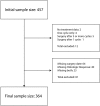Marginal structural models with dose-delay joint-exposure for assessing variations to chemotherapy intensity
- PMID: 29916309
- PMCID: PMC6728750
- DOI: 10.1177/0962280218780619
Marginal structural models with dose-delay joint-exposure for assessing variations to chemotherapy intensity
Abstract
Marginal structural models are causal models designed to adjust for time-dependent confounders in observational studies with dynamically adjusted treatments. They are robust tools to assess causality in complex longitudinal data. In this paper, a marginal structural model is proposed with an innovative dose-delay joint-exposure model for Inverse-Probability-of-Treatment Weighted estimation of the causal effect of alterations to the therapy intensity. The model is motivated by a precise clinical question concerning the possibility of reducing dosages in a regimen. It is applied to data from a randomised trial of chemotherapy in osteosarcoma, an aggressive primary bone-tumour. Chemotherapy data are complex because their longitudinal nature encompasses many clinical details like composition and organisation of multi-drug regimens, or dynamical therapy adjustments. This manuscript focuses on the clinical dynamical process of adjusting the therapy according to the patient's toxicity history, and the causal effect on the outcome of interest of such therapy modifications. Depending on patients' toxicity levels, variations to therapy intensity may be achieved by physicians through the allocation of either a reduction or a delay of the next planned dose. Thus, a negative feedback is present between exposure to cytotoxic agents and toxicity levels, which acts as time-dependent confounders. The construction of the model is illustrated highlighting the high complexity and entanglement of chemotherapy data. Built to address dosage reductions, the model also shows that delays in therapy administration should be avoided. The last aspect makes sense from the cytological point of view, but it is seldom addressed in the literature.
Keywords: Causal inference; bivariate exposure; marginal structural models; osteosarcoma; therapy delay.
Figures








References
-
- Lewis IJ, Nooij MA, Whelan J, et al. Improvement in histologic response but not survival in osteosarcoma patients treated with intensified chemotherapy: a randomized phase III trial of the European Osteosarcoma Intergroup. J Natl Cancer I 2007; 99: 112–128. - PubMed
-
- Wunder JS, Paulian G, Huvos AG, et al. The histological response to chemotherapy as a predictor of the oncological outcome of operative treatment of Ewing sarcoma. J Bone Joint Surg Am 1998; 80: 1020–1033. - PubMed
-
- Hernán MA, Brumback BA, Robins JM. Estimating the causal effect of zidovudine on CD4 count with a marginal structural model for repeated measures. Stat Med 2002; 21: 1689–1709. - PubMed
Publication types
MeSH terms
Grants and funding
LinkOut - more resources
Full Text Sources
Other Literature Sources
Medical

